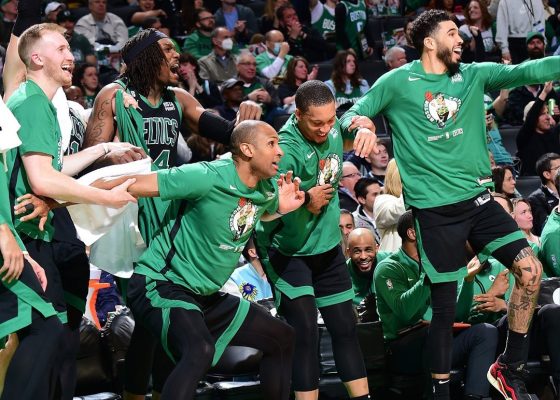In an 82-game season, losses are inevitable, and the likelihood is that you’re going to lose some games you’re supposed to win – just as you might win some you’re supposed to drop. For the most part, the Boston Celtics have done a solid job of navigating a season where there’s a clear bullseye on their back, and teams are coming at them with everything they’ve got.
Yet, as the ‘losses in winnable matchups’ have begun to pile up, there seems to be a trend forming, one that could indicate a growing confidence that teams have figured out how to stymie the Celtics’ offensive juggernaut. It all started with Boston’s November 22 loss to the Chicago Bulls — their second loss in three games against Billy Donovan’s team, where Chicago reverted to a game plan that saw them run out winners on October 25.
Since then, it feels like losses to the Orlando Magic, New York Knicks, Brooklyn Nets, and even, to a far lesser extent, the Golden State Warriors have all followed a similar defensive plan. The ‘blueprint,’ for lack of a better word, to creating the best chance of beating the Celtics contains five clear-cut points. If you execute on two or three of those points, then the odds are the Celtics are still going to find a way to win. Execute four of five of them, and suddenly, Boston looks toothless as they scramble and revert to early shot clock attempts and single-screen high pick-and-rolls.
1. Adjusting your pick-up points
The Celtics currently sit 15th in the NBA for drives per game and 24th for paint touches. As such, opposing teams can feel confident in adjusting their pick-up points to be a foot or two above the three-point line, as the likelihood is that Boston will look to do most of their work via off-ball screening actions around the perimeter.
By getting into the Celtics’ airspace earlier in a defensive possession, contesting every pass, dribble, or shot attempt, you’re forcing them into making quicker decisions and limiting the amount of ‘principal’ actions the team looks to run. Sure, there are times when the Celtics will punish you for this eager style of defense, driving closeouts, back cut on the wings, or simply running drag screens in transition, but the numbers show that the Celtics want to do their work on the perimeter, so it makes sense to make life as difficult as possible for them on every possession.
Under Ime Udoka, Boston’s offense was more deliberate. The Celtics would be happy to run the clock down a little as they set up their offense and found an open lane or saw a shooter whose defender was sagging off. Joe Mazzulla prefers an up-tempo style of offense, which is predicated on quick ball movement to generate wide-open threes as early in the clock as possible. It’s easier to defend those perimeter actions when you know your opponent wants to get their shot up early and are hunting those opportunities.
2. Push the tempo
It might feel like the Celtics give up a ton of points when defending fast break plays, yet in reality, they sit 11th in the league for opponents’ fast break points. However, what that statistic doesn’t show is how the Celtics are solid at stopping the initial action but find themselves stranded in the paint when the ball is kicked out and a half-court set begins to unfold — that’s what teams are looking for when ripping their defensive rebounds off the glass and launching blistering counterattacks.
Transition defense has been an Achilles heel for the Celtics for multiple seasons at this point and is a surefire way to give Boston some tough decisions on a possession-by-possession basis, allowing you to further speed them up on offense as you begin to take control of the pace of the game.
3. Crash the offensive glass
This isn’t an easy task for any team. The Celtics rank first in the NBA for percentage of defensive rebounds secured and are sixth in limiting second-chance points scored. However, there is a genuine lack of size within the Celtics roster that bigger or more explosive opponents can take advantage of — think Mitchell Robinson or Jarrett Allen for the types of players who can cause issues.
For the most part, teams will struggle to control the Celtics’ offensive glass; after all, they rank 2nd in the NBA for defensive box outs per game, yet if you can find a way to overpower them around the rim, there’s little they can do to adjust due to the lack of personnel that can bring size, speed, and strength to the rotation at the center position.
Still, this is clearly the most difficult aspect of the ‘blueprint’ and isn’t something that can be won solely on effort and grit. You need the right player(s) in your rotation to make this work.
4. Attack the paint with rip-throughs off the catch
The Celtics employ an aggressive switching defense; sometimes they switch one through five and others one through four with their big man in drop. Either way, there are ways to punish switches such as slipping screens or hunting mismatches. However, teams have been finding success when driving into the teeth of the defense directly off the catch, punishing any pre-switching (soft switching) that is taking place to find open pockets of space.
Throw some down screens into those rip-though actions, and suddenly, the Celtics’ defense looks average as they struggle to navigate the complexities of their own system while trying to react to their opponents’ quick decision-making.
If you watch how Mikail Bridges attacks the Celtics on this possession, you will get a good indicator of how quick rip-throughs are hurting the team’s defense. A quick Pistol action (hand-off on the wing into a ball screen) allows Bridges to quickly rip after receiving the pass, forcing Jayson Tatum to slip, while the screener keeps Robert Williams from getting too deep into the action. The result is an open shooting pocket around the nail as Tatum navigates the screen after having to flip his hips and change direction to chase down Bridges following the switch.
5. Get physical
I’m not of the belief that the Celtics are ‘soft.’ In fact, I seriously dislike that narrative and see it as an old trope that has become far too played out in recent seasons. Yet, there is some truth to how the Celtics alter their approach when teams get scrappy, especially if they’re physically challenging you on drives or around the boards.
It’s not that the Celtics wilt under the heat of battle, but rather, they look for new ways to generate their offense or limit their opponents on the defensive end. It’s like taking the detour rather than sitting in traffic, you’re going to get where you want, but it might add some more miles to the clock and cost you additional gas.
There’s nothing wrong with preserving your body and avoiding contact when the option is there, but if you can force the Celtics to begin taking the longer route, you’re taking them away from their initial gameplan, and that’s going to give you an advantage for the rest of the game.
Final thoughts
None of these ‘steps’ are reinventing the wheel, and for the most part, every team in the NBA is looking to control these areas of the floor. Nevertheless, it does feel like when all of these aspects are combined, it equals a recipe that the Celtics haven’t figured out how to counter yet, and it’s empowering their opponents to take the game to them — leading to some good results.
Luckily, there are still five weeks until the regular-season ends, so there is plenty of time for Mazzulla and the coaching staff to start fixing some of these blemishes in the Celtics’ makeup, but with games ticking down and another tough stretch of form, those changes need to happen soon, otherwise, we will be looking at another run of Game 7’s and we all saw the toll that took last season.






